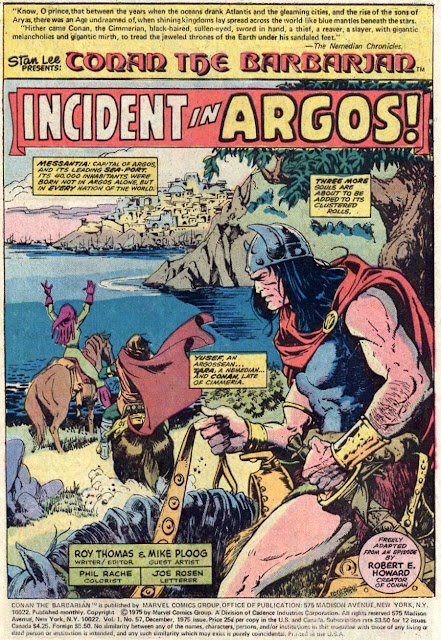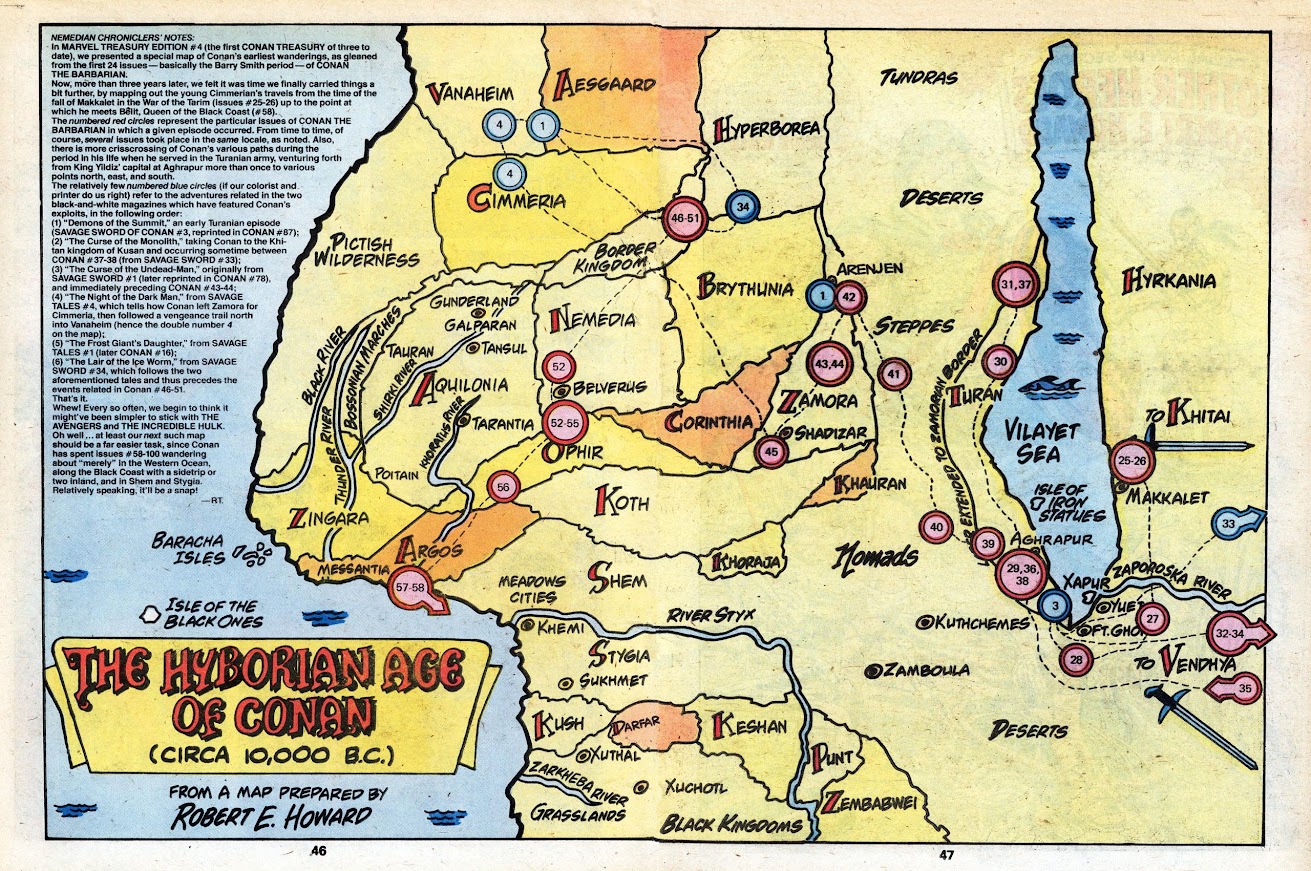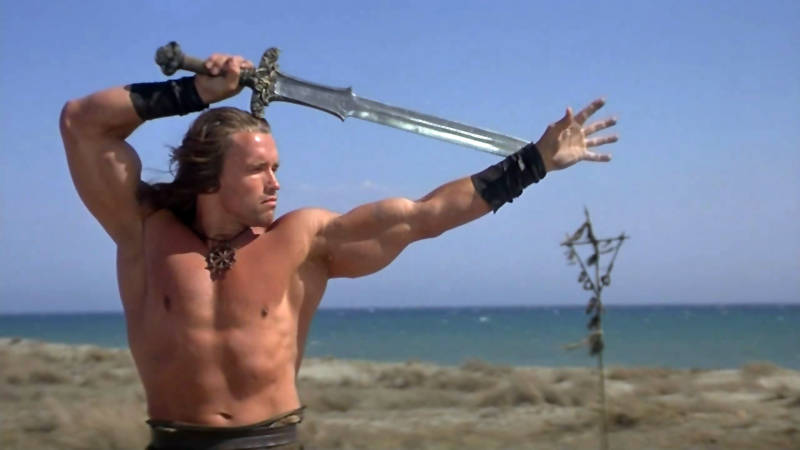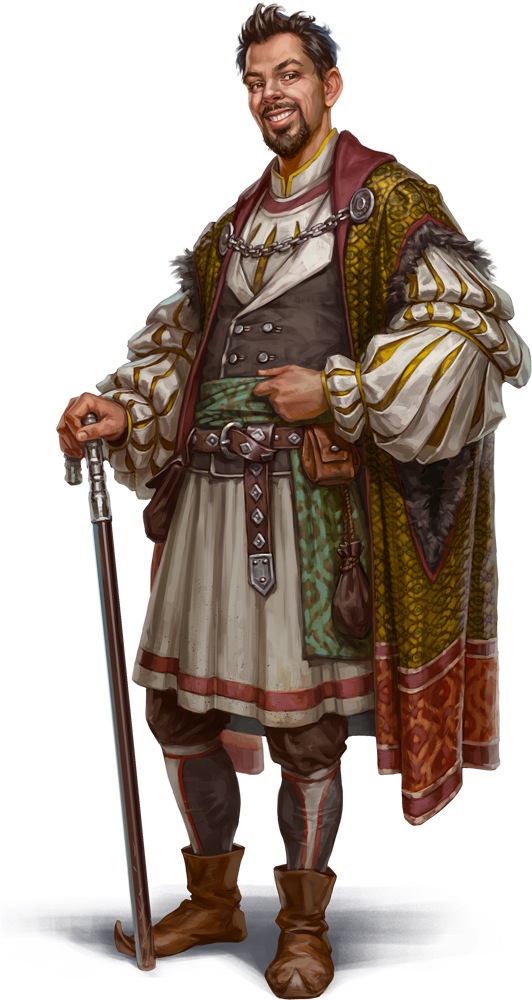-- INCIDENT IN ARGOS --
At the beginning of Robert E. Howard's Conan story, Queen of the Black Coast, the mighty barbarian is seen on horseback, racing down to the wharf of Messantia with guardsmen hot on his trail. Depending on where you read, you'll find different tales--backstories to Howard's short story--depicting the details of Conan's previous time in Argos and the reason for his flight from the guards. One of the best interpretations of this backstory I have just read in issue 57 of Marvel's Conan The Barbarian comic (reprinted and digitally remastered in Dark Horse's The Chronicles of Conan Vol. 8 - Brothers of the Blade And Other Stories.)
Roy Thomas is at the top of his game here. The issue grabs you at the beginning and doesn't let go. The action is so cinematic--I saw it all play out, in real time, in my head--delivered through the art by Mike Ploog.
A couple of interesting details:
Messantia Town Guard.
Messantia town guard wears a tabard over their armor that is checkered, black and orange, at the shoulders to the breast, at which point it becomes a solid, muted tan color. Emblazoned on the chest is a design/symbol/sigil that looks to be akin to a Christian Cross, but with a wide trunk and capped off at the top so that it looks like a double letter "T". Interesting: From looking on the net, the colors of the original (the tabard) were changed when the book was remastered for the collection.
The guards wear simple conical steel caps with cloth or leather covering at the ears and the back of the neck (to keep the sun off the back of the neck?). Some, but not all, of the guards have a Shemite style wide cloth band around the brim of their helm. It seems the higher ranks have these. And some wear tebennas (capes), although it is clear that the lowest ranking guards do not wear them.
Armor, worn under the tabard, is probably either leather or chain, depending on the individual guard's station, position, or rank. Some carry polearms. There is an exciting couple of frames where a guard swings his pollaxe at Conan, who has his hands chained together. The barbarian swings his arms up, spreading his hands, taking the blow on the chain--which splits the staff of the polearm. Conan then slams his hands, again using the chain, up against he guard's head, knocking off the guardsman's helm and knocking him out. Retrieving the keys from the man's waist, Conan fumbles with freeing himself as the crowd of civilians scream and run past him. His hands free, gripping the chain, he swings it through the air so that is wraps around an approaching guard's neck, like a whip, taking that one out. Conan is the MAN!
The guards wear wide leather belts, and all have some style of sword hanging in its sheath over a hip. Legs are covered by grey-green dyed billowy wool breeches, and on the feet are worn shin-high leather boots that have large flaps that fold over like those favored by seamen. But, footwear seams to be chosen by the individual, because other similar boots are seen in the story. Lowly guardsman, sergeant, or captain, all seem to be sleeveless by tabard and armor. Some wear armbands or wrist bracers.
Note that the High Constable of Messantia is seen (from the chest up) when Conan steals his horse. Although his helm is similar, his dress looks to be much different than the guards.
The King's Coin.
At one point in the story, Conan is captured and knocked unconscious. A strange, robed figure pays to have him placed as a slave crewer on a ship. It is guards, not pirates, endeavoring in this enterprise, and, in a twist, the robed figure turns out to be one of Messantia's Judges--the same judge that holds court with Conan at the end of the tale (although Conan never makes the connection--Roy Thomas brilliant reveals this information to the reader only by highlighting a ring worn on the judge's finger).
The guardsmen are paid five dinaros for the kidnapping. I'm not sure if this translates to five silver pieces or what the coins are worth.
Sorcery!
During the tale, Conan meets an old woman with one eye. She gave one of her eyes willingly, long ago, to a Zamorian sorcerer in return for the Sight--the ability to see the future. Conan sees his future in the bowl of water the old hag has placed in front of him. He sees himself master of a ship (Queen of the Black Coast). He sees himself crowned, sitting on a throne (The Hour of the Dragon). He sees himself crucified (A Witch Shall Be Born). All stories that are in Conan's future.
Neat!
At the end of the story, Conan is a fugitive, riding the High Constable's horse, down to the docks, in hopes of finding a ship and leaving Argos swiftly...which is where Queen of the Black Coast begins!
The pics below are not the remastered versions:



At the beginning of Robert E. Howard's Conan story, Queen of the Black Coast, the mighty barbarian is seen on horseback, racing down to the wharf of Messantia with guardsmen hot on his trail. Depending on where you read, you'll find different tales--backstories to Howard's short story--depicting the details of Conan's previous time in Argos and the reason for his flight from the guards. One of the best interpretations of this backstory I have just read in issue 57 of Marvel's Conan The Barbarian comic (reprinted and digitally remastered in Dark Horse's The Chronicles of Conan Vol. 8 - Brothers of the Blade And Other Stories.)
Roy Thomas is at the top of his game here. The issue grabs you at the beginning and doesn't let go. The action is so cinematic--I saw it all play out, in real time, in my head--delivered through the art by Mike Ploog.
A couple of interesting details:
Messantia Town Guard.
Messantia town guard wears a tabard over their armor that is checkered, black and orange, at the shoulders to the breast, at which point it becomes a solid, muted tan color. Emblazoned on the chest is a design/symbol/sigil that looks to be akin to a Christian Cross, but with a wide trunk and capped off at the top so that it looks like a double letter "T". Interesting: From looking on the net, the colors of the original (the tabard) were changed when the book was remastered for the collection.
The guards wear simple conical steel caps with cloth or leather covering at the ears and the back of the neck (to keep the sun off the back of the neck?). Some, but not all, of the guards have a Shemite style wide cloth band around the brim of their helm. It seems the higher ranks have these. And some wear tebennas (capes), although it is clear that the lowest ranking guards do not wear them.
Armor, worn under the tabard, is probably either leather or chain, depending on the individual guard's station, position, or rank. Some carry polearms. There is an exciting couple of frames where a guard swings his pollaxe at Conan, who has his hands chained together. The barbarian swings his arms up, spreading his hands, taking the blow on the chain--which splits the staff of the polearm. Conan then slams his hands, again using the chain, up against he guard's head, knocking off the guardsman's helm and knocking him out. Retrieving the keys from the man's waist, Conan fumbles with freeing himself as the crowd of civilians scream and run past him. His hands free, gripping the chain, he swings it through the air so that is wraps around an approaching guard's neck, like a whip, taking that one out. Conan is the MAN!
The guards wear wide leather belts, and all have some style of sword hanging in its sheath over a hip. Legs are covered by grey-green dyed billowy wool breeches, and on the feet are worn shin-high leather boots that have large flaps that fold over like those favored by seamen. But, footwear seams to be chosen by the individual, because other similar boots are seen in the story. Lowly guardsman, sergeant, or captain, all seem to be sleeveless by tabard and armor. Some wear armbands or wrist bracers.
Note that the High Constable of Messantia is seen (from the chest up) when Conan steals his horse. Although his helm is similar, his dress looks to be much different than the guards.
The King's Coin.
At one point in the story, Conan is captured and knocked unconscious. A strange, robed figure pays to have him placed as a slave crewer on a ship. It is guards, not pirates, endeavoring in this enterprise, and, in a twist, the robed figure turns out to be one of Messantia's Judges--the same judge that holds court with Conan at the end of the tale (although Conan never makes the connection--Roy Thomas brilliant reveals this information to the reader only by highlighting a ring worn on the judge's finger).
The guardsmen are paid five dinaros for the kidnapping. I'm not sure if this translates to five silver pieces or what the coins are worth.
Sorcery!
During the tale, Conan meets an old woman with one eye. She gave one of her eyes willingly, long ago, to a Zamorian sorcerer in return for the Sight--the ability to see the future. Conan sees his future in the bowl of water the old hag has placed in front of him. He sees himself master of a ship (Queen of the Black Coast). He sees himself crowned, sitting on a throne (The Hour of the Dragon). He sees himself crucified (A Witch Shall Be Born). All stories that are in Conan's future.
Neat!
At the end of the story, Conan is a fugitive, riding the High Constable's horse, down to the docks, in hopes of finding a ship and leaving Argos swiftly...which is where Queen of the Black Coast begins!
The pics below are not the remastered versions:










